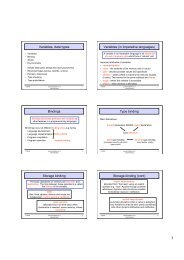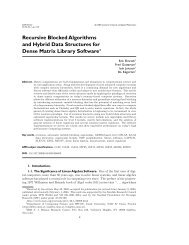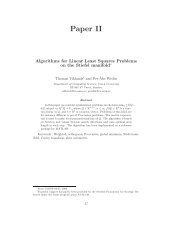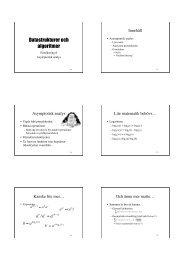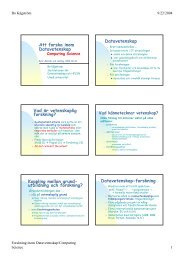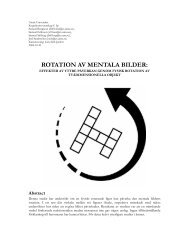Designing a persistent online strategy game - Department of ...
Designing a persistent online strategy game - Department of ...
Designing a persistent online strategy game - Department of ...
You also want an ePaper? Increase the reach of your titles
YUMPU automatically turns print PDFs into web optimized ePapers that Google loves.
8 Chapter 2. Methods<br />
perform brainwriting as well, such as passing ideas on to the next person who then<br />
develops the idea further [55].<br />
2.5 Prototyping<br />
Prototyping is used to test and communicate a design. With prototypes different designs<br />
can be examined more closely. They can also be used to evaluate usability and clarify<br />
requirements [52].<br />
A prototype can be anything from a sketch on a piece <strong>of</strong> paper to complex s<strong>of</strong>tware. Two<br />
main kinds <strong>of</strong> prototyping are high-fidelity (hi-fi) and low-fidelity prototyping (lo-fi).<br />
Hi-fi prototypes are similar in look and feel to the final product, but they do not have<br />
the same functionality. Hi-fi prototypes can for example be used to test the usability<br />
with end users. A problem with hi-fi prototypes is that the users may expect too much<br />
<strong>of</strong> them, because it looks like a real product. They may also be reluctant to suggest too<br />
drastic changes in the design.<br />
Lo-fi prototypes are simple and cheap prototypes, <strong>of</strong>ten made in paper. They can be<br />
sketches <strong>of</strong> the user interface or a usage scenario <strong>of</strong> the product. Lo-fi prototypes are<br />
used to explore different design ideas. One disadvantage <strong>of</strong> lo-fi prototypes is that it<br />
might be hard to predict how the users will interact with the final system [52].<br />
2.6 Evaluation<br />
Evaluating the design is a very important part <strong>of</strong> designing an interactive system. It<br />
can be performed to make sure that all requirements are met, that the product is usable<br />
and to determine if users like to use the product. Evaluation has traditionally concerned<br />
users’ objective performance, such as time to complete a task, but there is a growing<br />
trend towards also evaluating users’ subjective experience [52].<br />
Evaluation can be performed in a lab or in a natural environment. In the lab interaction<br />
can be observed as an isolated event and the evaluator has more control over the<br />
situation. Some aspects are however best evaluated in their natural environment. In<br />
real life, interaction can be interrupted by telephone calls, people and other tasks, which<br />
makes it harder to perform a task from the beginning to the end. Some systems are also<br />
meant to be used by several people. If it is important to see how a system is used in<br />
real life, it can be better to evaluate it where it is actually meant to be used.<br />
Evaluation can roughly be divided into two sets <strong>of</strong> methods; those that involve users<br />
and those that do not. A widely used method that does not involve users is heuristic<br />
evaluation. In heuristic evaluation an evaluator checks the system against a list <strong>of</strong> design<br />
guidelines. The purpose is to find areas where the system violates the guidelines and<br />
correct them. Heuristic evaluation can be performed early in the design when there is<br />
no real system to test with users.<br />
Involving users in evaluation can be performed in different ways. One way is to interview<br />
them, this way the evaluator can learn their thoughts and feelings about a system. But<br />
the evaluator can not see how the users interact with the system. Another way is to



